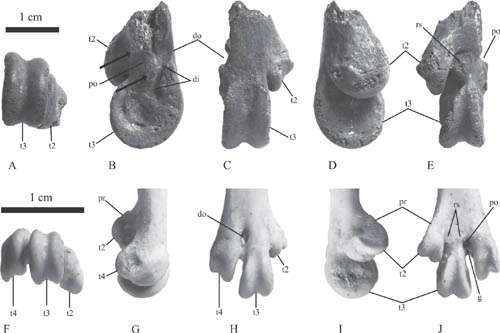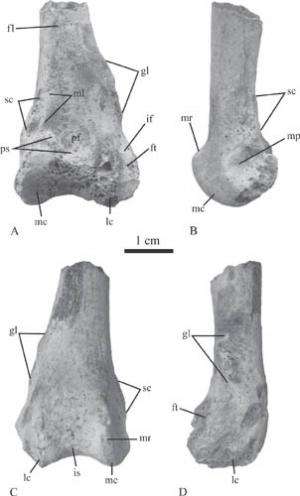Large anseriform fossils found from the late Eocene of Xinjiang, China

The fossil record of anseriforms in the Paleogene of the Northern Hemisphere is somewhat limited in terms of its overall diversity. Much of that early Cenozoic record is of the extinct Presbyornithidae, known from the Middle Paleocene through the Middle Eocene. Drs. Thomas A. Stidham and NI Xi-Jun, Institute of Vertebrate Paleontology and Paleoanthropology (IVPP), Chinese Academy of Sciences, reported two new avian fossils from the Late Eocene of Xinjiang in western China. According to the study published in Vertebrata PalAsiatica 52, these two bones are possible first occurrence of the extinct anseriform group Romainvilliinae (Anatidae) within China and Asia, thus providing new material for studying the evolution and biogeography of romainvilliines.
Two new anseriform bones, a partial distal tarsometatarsus and a distal femur, were discovered from the Paleocene-Eocene Irtysh River Formation at a locality near Xiaerhete Village, about 6 km northwest of Jeminay City, where is very close to the border between China and Kazakhstan. Geographically, the Xiaerhete fossil locality lies in the Jeminay-Kaba-Burqin Basin, which is generally regarded as the eastern part of the Zaysan Basin. The Xiaerhete locality has produced several fossil amiid fish remains, two taxa of turtles (a trionychid and a testudinoid), one species of crocodilian, and tooth and bone fragments of mammals.
The tarsometatarsus has several anseriform and anatid characters, and a combination of traits only reported from the romainvilliines among waterfowl. The absence of a medial flange on the second trochlea, its large size similar to extant swans, and asymmetrical proximal end of the plantar side of the third trochlea indicate that this specimen represents a new unnamed taxon. The equally large femur specimen exhibits morphology consistent with the anatid, and possible romainvilliine, Cygnopterus affinis from the Early Oligocene of Belgium.

The known mammalian faunas of the Late Eocene of Europe and Asia differ significantly, but that biogeographic division broke down during near the Eocene-Oligocene boundary leading to the mammalian 'Grande Coupure' in Europe with the invasion of Europe by Asian mammalian clades. However, the contemporaneous occurrence of Romainvilliinae and some small mammals in both Europe and Asia in the Late Eocene would seem to support at least a filter on dispersal or geographic movement of tetrapods rather than a complete ban on immigration before the enmasse movement of mammals (and presumably other taxa) between Europe and Asia at the beginning of the Oligocene (the Grande Coupure) that is associated with significant climatic (global cooling) and environmental change.
"If these unnamed fossils represent Asian romainvilliines, they support a geographic range extension of the group, the occurrence of large body-sized romainvilliines in the Eocene, and an avifaunal biogeographic link between Europe and Asia during the Eocene prior to the end of the Turgai Strait as a dispersal barrier to most mammals", said Dr. Stidham, first author of the study.
More information: The report is available online: www.ivpp.cas.cn/cbw/gjzdwxb/xb … 0121384982654940.pdf
Journal information: Vertebrata PalAsiatica
Provided by Chinese Academy of Sciences




















